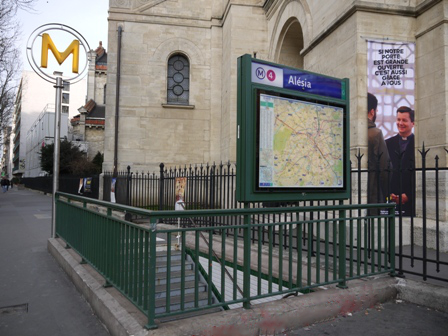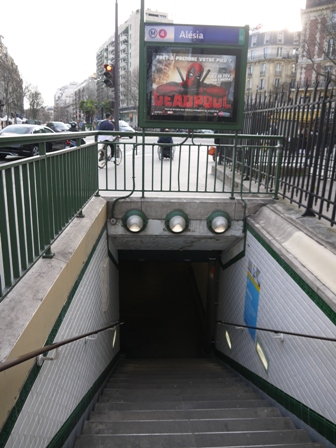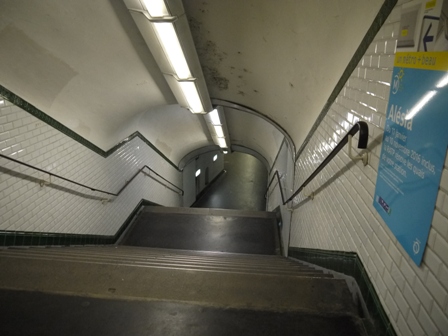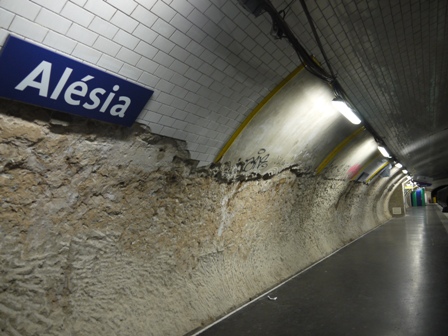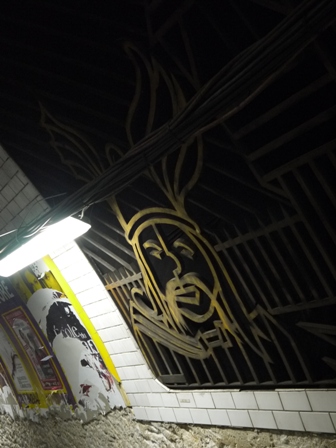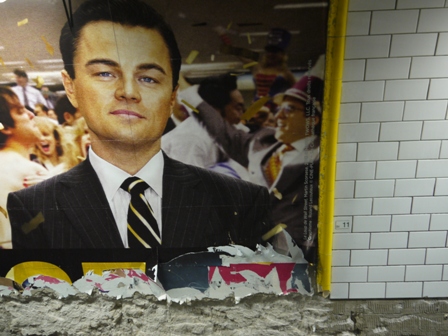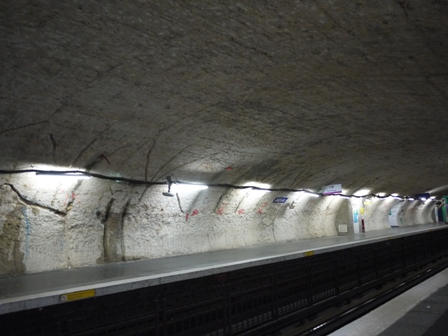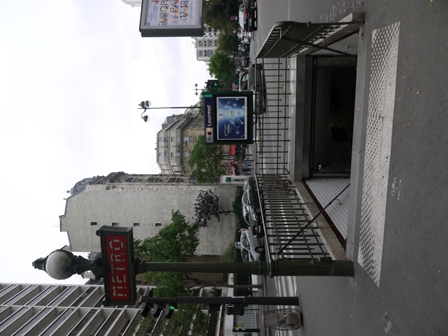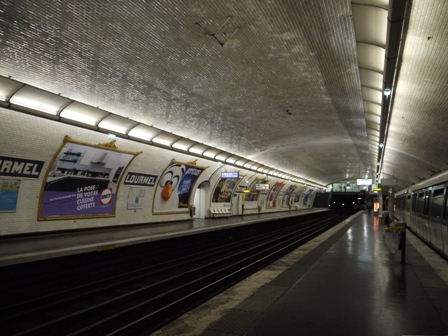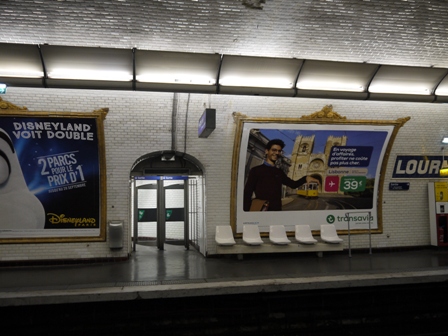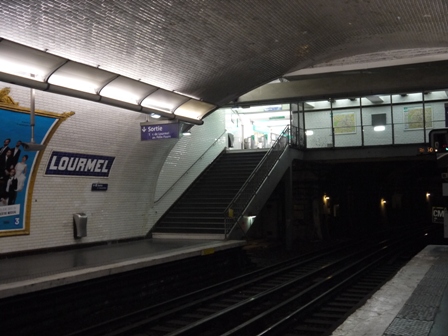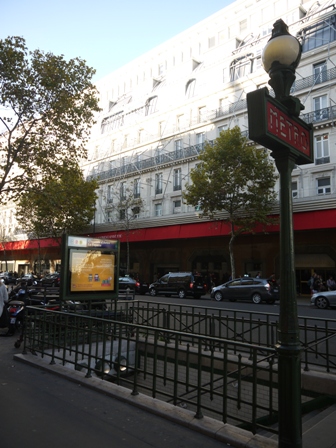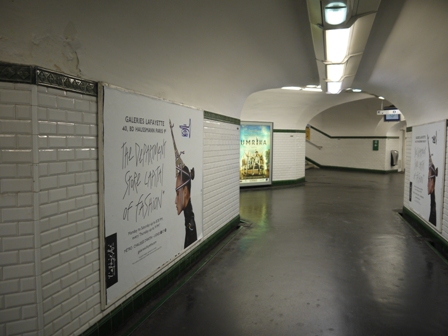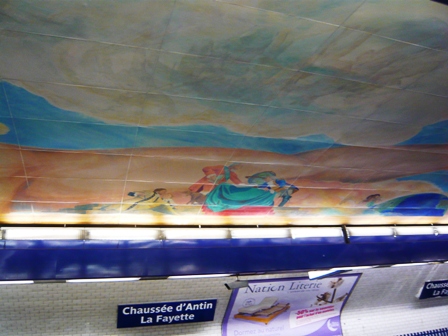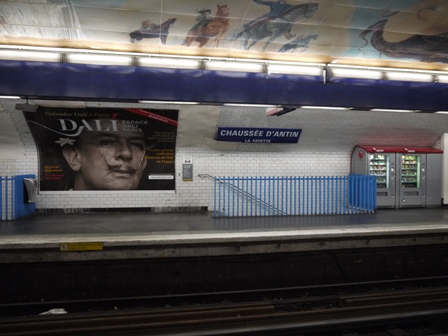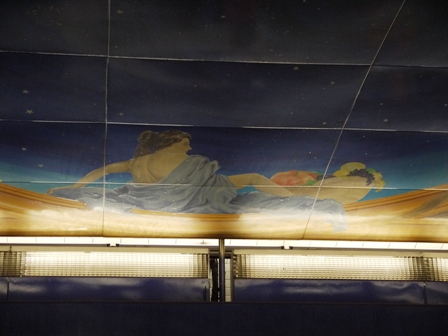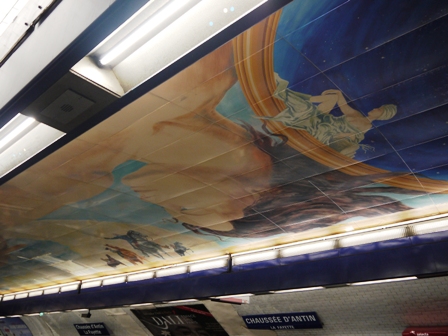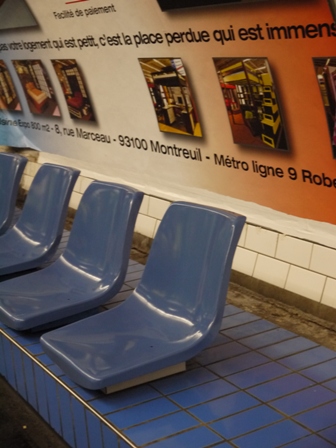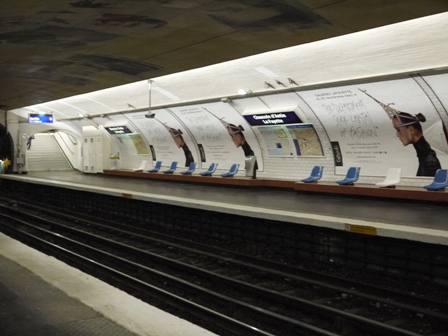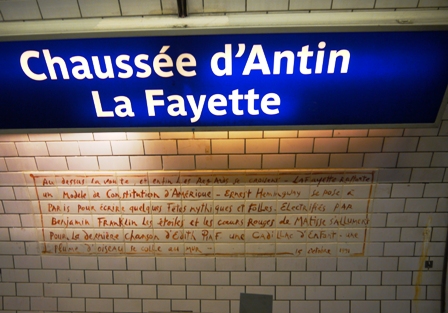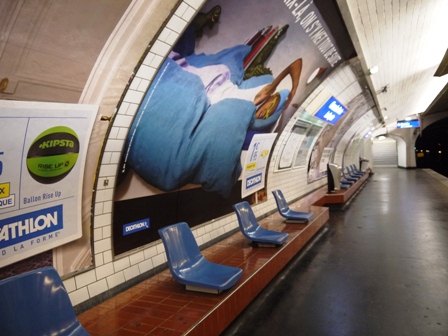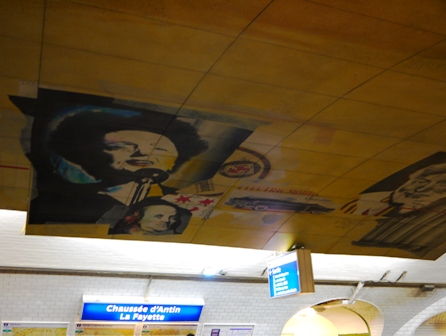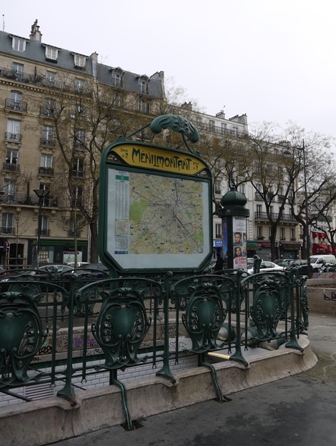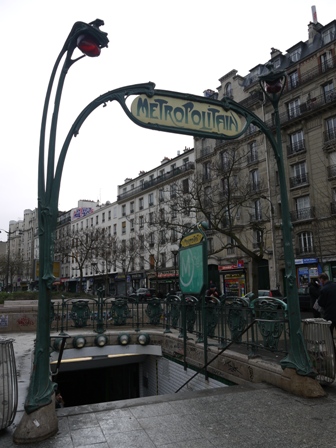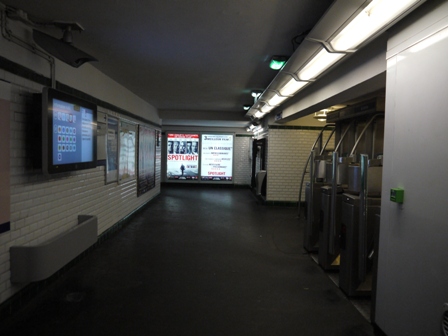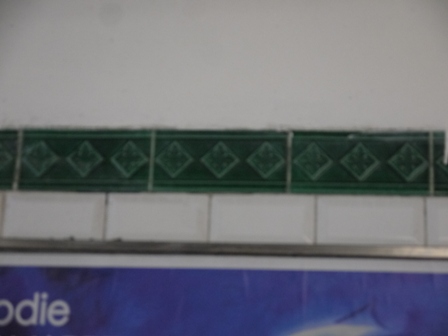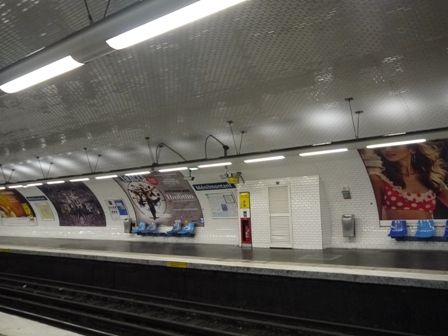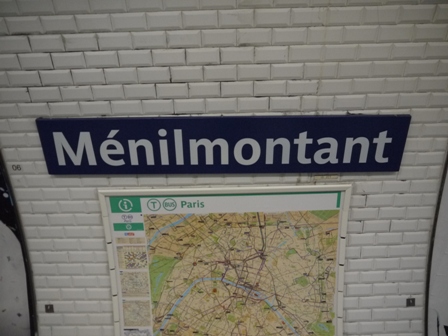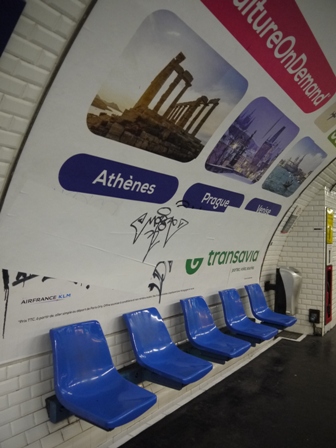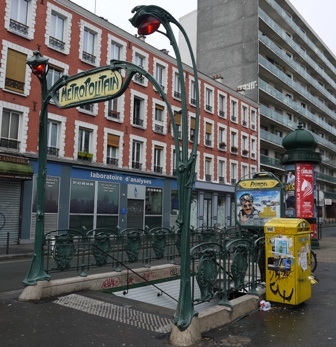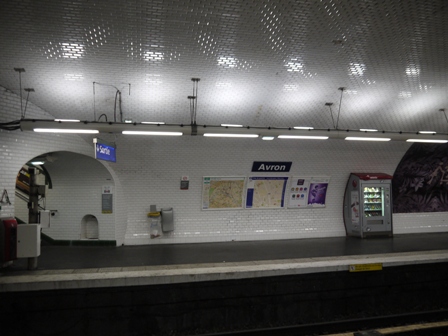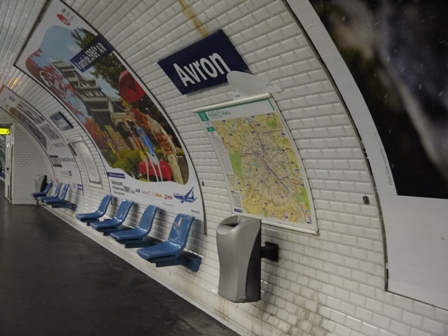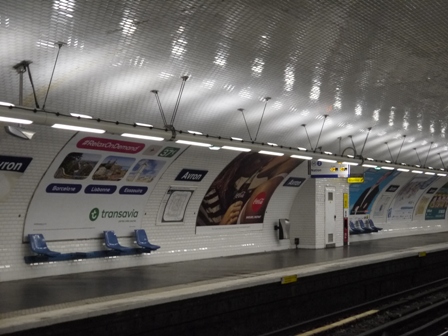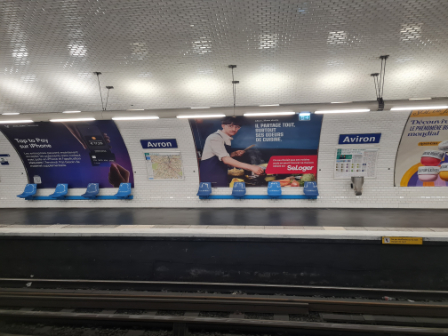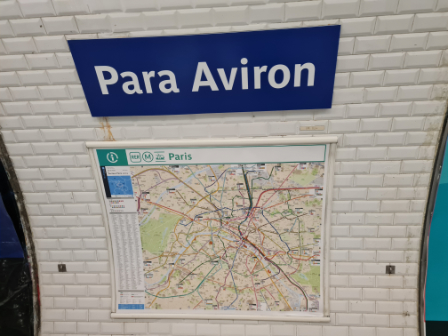- Details
Alésia is an underground station which opened on 30 October 1909 when the line was extended south from Raspail and Porte d'Orléans. It takes its name from the battle of Alésia in the Gallic wars where Vercingetorix surrendered to Julius Cesar.
It is situated in the 14th arrondissement.
The station is served by the metro line 4. It is in process to be renovated for the refurbishment of the line and the installation of platform barriers scheduled for 2020.
The original lamppost of the entrance has been replaced with a silver pole of the 1970's period. A yellow light shaped as a large letter M is surrounded by two steel circles.
The station sign is a green frame with glass. In it has been placed a map of the metro network. Above the map is a blue bar with the station name and to the side of it the line number of the metro.
Entrance to the station. Metal handrails have been fixed to the side walls. The walls are tiled with small white ceramic tiles and green border tiles.
The station sign, which is intergrated into the short section of theenclosure shows changing advertisements at this side.
The enclosure is made of two panels of green metal bars on a low stone base. The right side is the fence of the adjacent church.
At the back - at ground level - are three round lighs in green light fittings.
Stairs down a corridor towards the platform. Metal handrails have been attached to the walls.
The walls are tiled until about shoulder height. The ceiling above the green border tile is painted white.
A continuous row of lights has been placed in the apex of the ceiling.
The platform signage is a blue plasticised sign without frame and white lettering. Unlike the walls in the corridor, the tiles on the wall here are white and flat.
The lighting has been replaced with temporary light.
The lower parts of the tiled walls and advertising boards have been already removed.
The floor has been painted grey.
Along the platform is a ventilation and evacuation shaft. The grill of it is decorated with a figure of a Gallic warrior in cape and horned helmet in reference to Vercingetorix and the Gallic wars.
Leonardo diCaprio looks out of a half-demolished advertising board, in a yellow ceramic frame.
In 2016 the walls and ceiling have been completely stripped to let the walls dry out for several weeks before they are renovated.
The fence between the tracks is typical for the line.
- Details
Lourmel opened on 27 July 1937 when the line was extended from La Motte-Picquet - Grenelle to Balard. It takes its name from Frédéric Henri Le Normand de Lourmel (1811-1854), a general in the French army.
It is situated in the 15th arrondissement.
The station is an underground station served by the metro line 8.
Entrance to the station.
It is enclosed in a green metal fence made of bars of different lengths on a stone base. The station sign is fixed to the fence in a square metal frame. The top shows information of the metro line number and the name of the station. The lower part contains changing advertising.
Metal handrails are fixed to the white tiled walls on either side.
Unlike other other entrances of the same type, this station has no round lights fixed to the far end of the entrance.
On the left side of the entrance is a green lamppost designed by Derveaux. It incorporated a red panel with the word Metro in white transparent letters which is lit up at darkness.
A thick row of plasticised circles mark the entrance for visually impaired passengers.
The station has a centre and a side platform. Advertising panels surrounded by mustard coloured ceramic tiles have been intergrated along the wall. They are decorated with two small corner and one large centre flower embelishment on the top.
The vaulted ceiling is tiled in small white rectangular ceramic tiles with a raised centre. The tiles continue until the ground.
The floor is painted in a grey non-slip covering.
The platform edges are marked with a thick white line and a grey band of raised circles.
Platform lights have been placed over the edge of the the side platform and the centre of the centre platform.
The lightling consists of lights fixed on a lower metal bar are reflecting from the curved upper sheet. They have been designed by Bruno-Gaudin.
Some white plastic seats have been fixed to the wall with a metal beam. Next to them is a steel frame to lean against while waiting.
Passengers can exit the platform (direction Balard) through a short corridor with metal framed glass doors. Passengers push the metal centre part to open the doors.
An escalator leads directly to the surface.
Access to the platform from the connecting bridge is via a short set of stairs.
- Details
The station opened on 5 November 1910 when the line 7 started its operation.
It is situated in the 9th arrondissement opposite the department store Galeries Lafayette.
Chaussée d'Antin - La Fayette is served by the metro lines 7 and 9. Both lines have underground platforms.
The entrance to the station is surrounded by a green metal enclosure with simple bars of different lengths.
The walls are tiled in white ceramic tiles with a raised centre. They are topped with green border tiles.
Metal handrails have been fixed to the wall.
At ground level are four round lights in green light fittings.
To the left of the entrance is a green lamppost with a red sign. The lamppost is topped with a white ball shaped light.
The connecting corridor is tiled in white ceramic tiles with raised centres until about shoulder height. The last row consists of green tiles with four-petalled flowers in a diamond shape.
Metal advertising boards have been stuck on top of the tiles.
The top of the walls and ceiling are painted white.
A row of lights have been attached to the heighest point of the ceiling.
Platform Line 7
Line 7 started operation on 5 November 1910.
The slightly vaulted ceiling is made up of large rectangles which have been painted with several scenes.
The platform signage consists of the station name written in white upper and lower case letters on a dark blue plasticised background without frame.
Access to the platforms is from the side by ascending some stairs, which are separated from the platform by a light blue fence.
In a corner are two vending machines.
The ground is painted grey. The edge of the platform is marked with a white line and an area of raised circles.
Scene on the ceiling showing stars in the night sky.
The lights are encased in dark blue metal rectangular boxes in the Andreu-Motte style.
Medium blue plastic seats have been fixed to a base of matching blue ceramic flat tiles.
Behind the seating are large advertising boards in a thin metal frame.
Platform Line 9
Line 9 started operation on 3 June 1923.
Line 9 has two side platforms. Entrance to the platforms is from the end.
The slightly curved walls are tiled in white, flat rectangular tiles.
The lights are hidden in the ceiling.
The platform sign is a large blue lightbox in a metal frame with the name "Chaussée d'Antin La Fayette" written in white letters.
Underneath the sign is a "note" written in ocre paint on a background of white tiles and framed with a drawn line.
"Au dessus la voute, et enfin les regards se croissent - LaFayette rapporte un modèle de Constitution d'Amérique - Ernest Hemingway se pose à Paris pour écrire quelques fetes mythiques et folles. Electrifiés par Benjamin Franklin les étoiles et les rouges de Matisse s'allument pour la dernière chanson d'Edith Piaf. Une Cadillac d'enfant - une plume d'oiseau se colle au mur. 15 octobre 1991"
Light blue plastic seats have been fixed on a base with red ceramic tiles.
Behind the seats are large advertising boards with thin metal frames.
The wall is tiled in small white tiles with a flat surface.
The platform has a false ceiling which is curved. The base colour of the ceiling is yellow.
One of the personalities shown is Edith Piaf - a singer also known "The little Sparrow".
- Details
The station opened on 31 January 1903 as part of the original section from Alexandre Dumas (then called Bagnolet) to Anvers.
Ménilmontant is situated on the border of the 11th and 20th arrondissements.
The underground station is served by the metro line 2.
The station sign is in the art nouveau style.
In the centre of the green metal panel is a map of the network. Above this is a narrow panel with the station name written in green on a yellow background using the art nouveau font. It also shows the number of the metro line.
Attached to the top is a green cupped flower light.
The station sign is attached to the Guimard fence and the ground.
The green fence is placed on a small stone sims.
The entrance to the station is not marked by an area of white raised circles.
On either side of the entrance is a large green lamppost in the shape of a flower with a red light.
Between the lampposts is a yellow oval sign with the the word Metropolitain written in green.
At the other end of the entrance, at ground level, are five small round lights in green fittings.
The back of the station sign shows a large metro logo. It is fixed to the side of the fence.
Metal handrails have been fitted to the tiled walls.
At the wall in the corridor is a display screen with traffic information of other lines and bus departures.
The walls are tiled nearly to the top. The ceiling is flat and painted white.
The walls in the corridor are tiled to about shoulder height in white rectangular tiles with a raised centre.
The green border tiles have a raised pattern of three diamonds with flowers.
The wall above the border and the ceiling are painted white.
The side platforms are not separated from the tracks by barriers.
The vaulted ceiling and the walls are tiled in white rectangular tiles with a raised centre, which reflect some of the light.
Lights in the form of a long tube are hung from the ceiling and fixed with pairs of wires.
The platform signage consists of the station name in white mixed-case letters on a dark blue background. The sign is not framed.
The sign has been placed on the tiled wall.
Underneath is a plan of the tram and bus network in a white frame.
Medium blue plastic seats have been screwed to a blue metal bar fixed to the wall.
Behind them are large advertising boards in thin metal frames.
- Details
Avron is situated on the border of the 11th and 20th arrondissements.
It is an underground station served by the metro line 2.
The station opened on 2nd April 1903 when the line was extended to Nation.
The entrance to the metro station is under an art nouveau sign, which is held up by two lampposts in the shape of flowers. They are painted dark green. Their lights are red.
The art nouveau sign has the word Metropolitain in green capital letters written on a yellow background.
Both the lampposts and the green fence panels designed by Guimard are fixed on a low stone border.
Metal hand rails are fixed on the tiled walls.
The entrance is marked by a wide white strip with raised circles.
Entrance to the side platforms is from the side towards to end of it.
The vaulted ceiling and the walls are tiled in small white rectangular tiles with a raised centre, the so-called metro tiles.
The platform has no barriers.
The platforms have been furnished with light blue plastic seats mounted on a blue metal bar fixed to the wall.
Behind the seats are advertising boards with thin metal borders.
The platform sign consists of white mixed-case lettering on a dark blue plasticized sign without frame.
Underneath the sign is a map of the transport network in a white frame.
The platform lights are in a long tube strung by pairs of wires from the tiled ceiling.
The platform edge is marked with a band of raised circles and a white line to help visually impaired passengers.
It is tradition for the RATP to take part in in the tradition of April Fools jokes.
In 2024 it renamed a number of stations to celebrate the olympic and para-olympic games which take place later that year, as well as to highlight the week of olympic and para-olympic games (2 - 6 April 2024).
For a day, the platform of this station was renamed to Aviron and Para Aviron.

